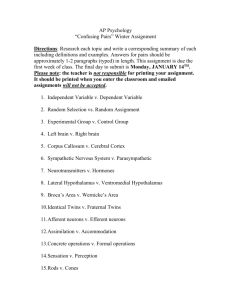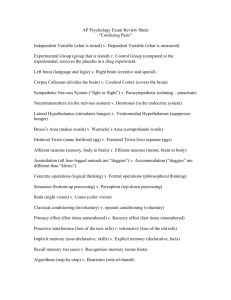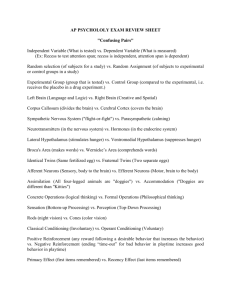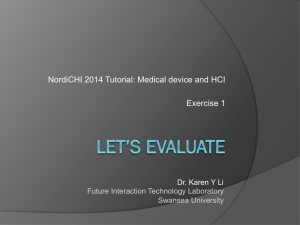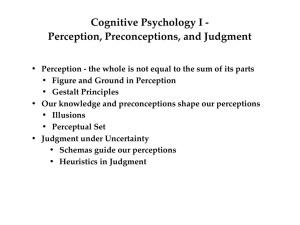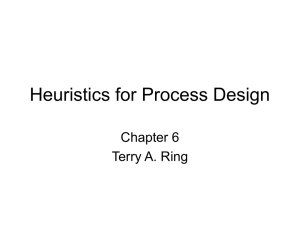Semi-automatic entity-relationship modelling
advertisement
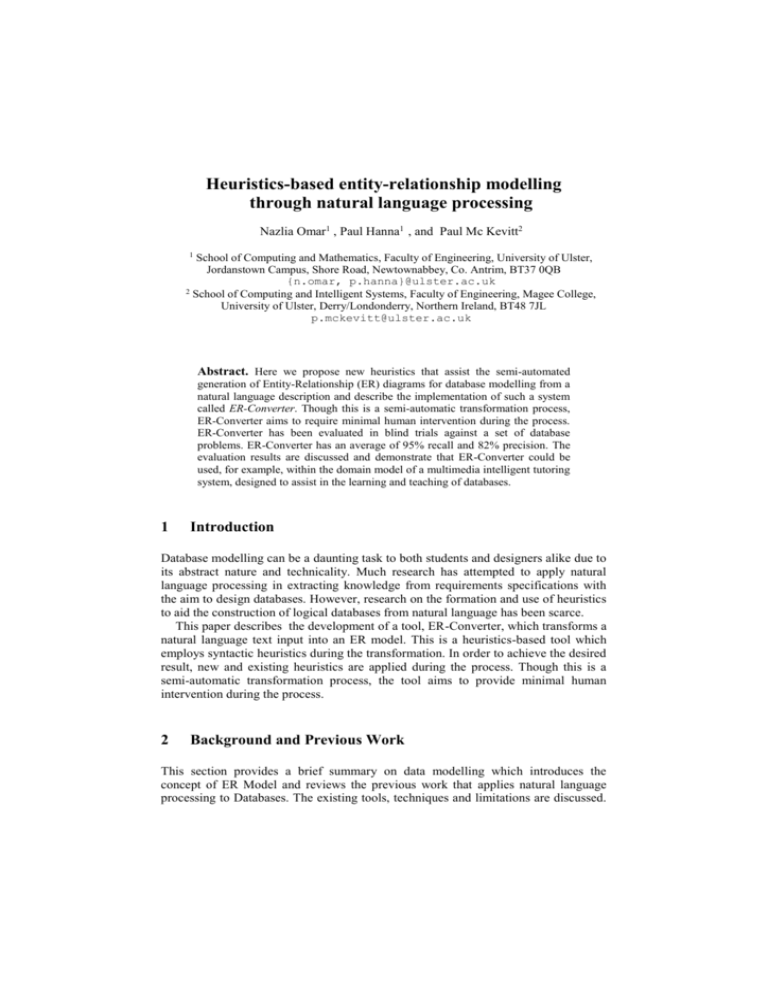
Heuristics-based entity-relationship modelling
through natural language processing
Nazlia Omar1 , Paul Hanna1 , and Paul Mc Kevitt2
1
School of Computing and Mathematics, Faculty of Engineering, University of Ulster,
Jordanstown Campus, Shore Road, Newtownabbey, Co. Antrim, BT37 0QB
{n.omar, p.hanna}@ulster.ac.uk
2 School of Computing and Intelligent Systems, Faculty of Engineering, Magee College,
University of Ulster, Derry/Londonderry, Northern Ireland, BT48 7JL
p.mckevitt@ulster.ac.uk
Abstract. Here we propose new heuristics that assist the semi-automated
generation of Entity-Relationship (ER) diagrams for database modelling from a
natural language description and describe the implementation of such a system
called ER-Converter. Though this is a semi-automatic transformation process,
ER-Converter aims to require minimal human intervention during the process.
ER-Converter has been evaluated in blind trials against a set of database
problems. ER-Converter has an average of 95% recall and 82% precision. The
evaluation results are discussed and demonstrate that ER-Converter could be
used, for example, within the domain model of a multimedia intelligent tutoring
system, designed to assist in the learning and teaching of databases.
1
Introduction
Database modelling can be a daunting task to both students and designers alike due to
its abstract nature and technicality. Much research has attempted to apply natural
language processing in extracting knowledge from requirements specifications with
the aim to design databases. However, research on the formation and use of heuristics
to aid the construction of logical databases from natural language has been scarce.
This paper describes the development of a tool, ER-Converter, which transforms a
natural language text input into an ER model. This is a heuristics-based tool which
employs syntactic heuristics during the transformation. In order to achieve the desired
result, new and existing heuristics are applied during the process. Though this is a
semi-automatic transformation process, the tool aims to provide minimal human
intervention during the process.
2
Background and Previous Work
This section provides a brief summary on data modelling which introduces the
concept of ER Model and reviews the previous work that applies natural language
processing to Databases. The existing tools, techniques and limitations are discussed.
Some of the work like DMG[10] provides a basis for the development of new
heuristics applied in ER-Converter.
2.1 Overview of Data Modelling
The first step in designing a database application is to understand what information
the database must store. This step is known as requirements analysis. The information
gathered in this step is used to develop a high-level description of the data to be stored
in the database. This step is referred to as conceptual design, and it is often carried out
using the ER model. ER models are built around the basic concepts of entities,
attributes, relationships and cardinality. An entity is an object that exists in the real
world and is distinguishable from other objects. These are typically derived from
nouns. Examples of entities include the following: a “student”, an “employee” and a
“book”. A collection of similar entities is called an entity set. An entity is described
using a set of attributes. The attributes of an entity reflect the level of detail at which
we wish to represent information about entities. Attributes may be derived from
adjectives and adverbs. For example, the “Student” entity set may have “ID_number”,
“Name”, “Address”, “Course” and “Year” as its attributes. A relationship is an
association among two or more entities. Relationships can be typically derived from
verbs. For example, we may have a relationship from this sentence: A student may
“take” many courses. “take” implies a relationship between the entity “student” and
“course”. Cardinality represents the key constraint in a relationship. In the previous
example, the cardinality is said to be many-to-many, to indicate that a student can
take many courses and a course can be taken by many students. In an ER diagram, an
entity is normally represented by a rectangle. An ellipse usually represents an attribute
meanwhile a diamond shape shows a relationship. Cardinality is represented by 1 for
the one-sided and M for the many-sided.
2.2 Applying Natural Language Processing (NLP) to Databases
Much work [2,5,6,10] has attempted to apply natural language in extracting
knowledge from requirements specifications or dialogue sessions with designers with
the aim to design databases. Dialogue tool [2] is a knowledge-based tool applied to
the German language for producing a skeleton diagram of an Enhanced EntityRelationship (EER) model. This tool is part of a larger database design system known
as RADD (Rapid Application and Database Development) which consists of other
components that form a complex tool. In order to obtain knowledge from the
designer, a moderated dialogue is established during the design process. The
transformation of the structure of natural language sentences into EER model
structures is a process which is based on heuristic assumptions and pragmatic
interpretation. The aim of the pragmatic interpretation is the mapping of the natural
language input onto EER model structures using the results of the syntactic and
semantic analyses. One major limitation in this system is that the accuracy of the EER
model produced depends on the size and complexity of the grammar used and the
scope of lexicon.
ANNAPURNA [5] is project aimed to provide a computerized environment for
semi-automatic database design from knowledge acquisition up to generating an
optimal database schema for a given database management system. ANNAPURNA
concentrated on the phases concerned with acquiring the terminological rules. The
first step in acquisition of the terminological knowledge involves extracting the
knowledge from queries and rules that have the form of natural language expressions.
The knowledge obtained would then be put into the form of S-diagrams. An Sdiagram is a graphical data model which can be used to specify classes (for example
room and door), subclass connections between classes (for example rooms and doors
are physical objects) and attributes. The limitation of the above work is that the use of
S-diagrams performs best when the complexity is small.
DMG [10] is a rule based design tool which maintains rules and heuristics in
several knowledge bases. A parsing algorithm which accesses information of a
grammar and a lexicon is designed to meet the requirements of the tool. During the
parsing phase, the sentence is parsed by retrieving necessary information from the
grammar, represented by syntactic rules and the lexicon. The parsing results are
processed further on by rules and heuristics which set up a relationship between
linguistic and design knowledge. The DMG has to interact with the user if a word
does not exist in the lexicon or the input of the mapping rules is ambiguous. The
linguistic structures are then transformed by heuristics into EER concepts. Though
DMG proposed a large number of heuristics to be used in the transformation from
natural language to EER models, the tool has not yet been developed into a practical
system.
E-R generator [6] is another rule-based system that generates E-R models from
natural language specifications. The E-R generator consists of two kinds of rules:
specific rules linked to semantics of some words in sentences, and generic rules that
identify entities and relationships on the basis of the logical form of the sentence and
on the basis of the entities and relationships under construction. The knowledge
representation structures are constructed by a natural language understander (NLU)
system which uses a semantic interpretation approach. There are situations in which
the system needs assistance from the user in order to resolve ambiguities such as the
attachment of attributes and resolving anaphoric references.
CM-Builder [8] is a natural language based CASE tool which aims at supporting
the analysis stage of software development in an object-oriented framework. The tool
uses natural language processing techniques to analyse software requirements
documents and produces initial conceptual models represented in Unified Modelling
Language. The system uses discourse interpretation and frequency analysis in
producing the conceptual models. CM-Builder still has some limitation in the
linguistic analysis. For example, attachment of postmodifiers such as prepositional
phrases and relative clauses is limited. Other shortcomings include the state of the
knowledge bases which are static and not easily updateable nor adaptive.
All the systems discussed here have user involvement during processing. Because
of the incomplete presentation of knowledge, ambiguities and redundancies, full
automation of the design process is fundamentally impossible [5]. As a consequence,
the tools must be able to interact with the designer, including ER-Converter. A semiautomatic design process is far more economical than an entirely manual process [5].
3 Heuristics to identify ER elements
Heuristics represent an indefinite assumption [10], often guided by common sense, to
provide good but not necessarily optimal solutions to difficult problems, easily and
quickly [11]. Research on the formation and use of heuristics to aid the construction
of logical database structures from natural language has been scarce. The only
existing work that proposes a large number of heuristics to be used in the
transformation from natural language to ER models is DMG [10]. However the work
has not been implemented. The authors of DMG proposed both syntactic and
semantic heuristics to be applied in extracting knowledge from requirements
specifications. Although E-R Generator [6] and RADD [2] utilized heuristics in their
work, they do not detail a precise set of heuristics in their approach. Chen [3]
suggested that the basic constructs of English sentences could be mapped into ER
schemas in a natural way and presented a set of rules to put forward the ideas. Though
the set are referred to as “rules”, Chen mentioned that they are better viewed as
“guidelines” as it is possible to find counter examples to them. Here we regard Chen’s
“rules” as heuristics as they are largely “rules-of-thumb” based on observations rather
than theoretically derived. Only heuristics for language syntax are considered and
proposed at this stage.
Here, a selection of the heuristics applied in the transformation from database
specifications to the data modeling constructs is presented. These heuristics are
gathered from past work [3,9,10] and some are newly formed. Some examples in
terms of sentences are provided to illustrate the application of heuristics which are
context dependent.
Heuristics to determine entities:
1.
2.
3.
Heuristic HE2: A common noun may indicate an entity type [3,10].
Heuristic HE3: A proper noun may indicate an entity [3,10].
Heuristic HE7: If consecutive nouns are present, check the last noun. If it is not
one of the words in set S where S={number, no, code, date, type, volume, birth,
id, address, name}, most likely it is an entity type. Else it may indicate an
attribute type.
Heuristics to exclude non-potential entity types candidates:
1.
Heuristic HEX: A noun such as “record”, “database”, “company”, “system”,
“information” and “organization” may not be a suitable candidate for an entity
type. For example, “company” may indicate the business environment and should
not be included as part of the entity types. Examples:
a) “An insurance company wishes to create a database to keep track of its
operations.”
b) “An organization purchases items from a number of suppliers.”
Heuristics to determine attributes:
1.
2.
Heuristic HA6: Genitive case in the noun phrase may indicate an attributive
function [10].
Heuristic HA8: If a noun is followed directly by another noun and the latter
belongs to set S where S={number, no, code, date, type, volume, birth, id,
address, name}, this may indicate that both words are an attribute. Else it is most
likely to be an entity.
Heuristics to determine relationships:
1.
2.
Heuristic HR1: An adverb can indicate an attribute for relationship [3].
Heuristic HR4: A verb followed by a preposition such as “on”, “in”, “by” and
“to” may indicate a relationship type. For example: “Persons work on projects.”
Other examples include “assigned to” and “managed by”.
Heuristics to determine cardinalities:
1.
2.
3.1
Heuristic HC2: The adjective “many” or “any” may suggest a maximum
cardinality. For example:
a) “A surgeon can perform many operations.”
b) “Each diet may be made of any number of servings.”
Heuristic HC3: A comparative adjective “more” followed by the preposition
“than” and a cardinal number may indicate the degree of the cardinality between
two entities. For example: “Each patient could have more than one operation.”
Heuristics’ Weights
The heuristics’ weights are assigned according to the confidence level that the event is
true. For example, HE2 (one of the heuristics to determine entity type) states that a
common noun may indicate an entity type. It has been given a weight of 0.5. This
basically means that 50% of the time this heuristic may produce the correct result, as
not all nouns are entity types. Though the assignment of the weights is mainly based
on intuition, these weights are also compared and reflected against the results
obtained from training set. Most of the values assigned lie between –1 and 1 with the
exception of HEX which is assigned a value of 100. This value acts as a safe border
that differentiates between an entity type and a non-entity type. For example, there
may be much evidence occurring for a word indicating it is an entity type. This is
reflected in the total sum of the weights of evidence found. As both entity types and
non-entity types have positive values, a value of 100 and over may indicate strongly
that a word may suggest a non-entity type. For attributes, all of the weights are
assigned with negative values. The main reason for this is that if a situation occurs
where a noun may represent an entity type but if at the same time it may also
represent an attribute, the weight on its identification as entity will be reduced. If this
value falls within a threshold of –0.2 and 0.4, user intervention may be required to
help identify its identity. The user will be prompted to decide whether the noun is an
entity or an attribute. This is the only point where user intervention is needed in the
process of generating the ER modelling concepts.
3.2 Training set
In order to test the newly developed heuristics, a manual test was carried out prior to
the implementation of ER-Converter. This stage is seen as an important phase as the
heuristics’ contributions need to be ascertained before proceeding to the
implementation phase. Ten examples were selected for the training dataset. These
examples, which are natural language requirements specifications, were gathered
mainly from database text books.
4
The ER-Converter Tool
Figure 1 depicts the architecture of ER-Converter. ER-Converter has been
implemented using Practical Extraction and Report Language (Perl). The natural
language processing involved in the process of translating the database specifications
into ER elements is purely based on syntactic analysis.
The process begins by reading a plain input text file containing a requirements
specification of a database problem in English. For this purpose, a parser is required
to parse the English sentences to obtain their part-of-speech (POS) tags before further
processing. Part of speech tagging assigns each word in an input sentence its proper
part of speech such as noun, verb and determiner to reflect the word’s syntactic
category [1]. The parser used here is Memory-Based Shallow Parser (MBSP) [4,12].
The parsed text is then be fed into ER-Converter to identify suitable data modeling
elements from the specification. The task requires several steps to be carried out in
order to achieve the desired ER model from the natural language input, each of which
is listed as follows:
Step 1: Part of speech tagging using Memory-based Shallow Parser
Step 2: Read natural language input text into system
Step 3: Apply heuristics and assign weights
Step 4: Human intervention
Step 5: Attachment of attributes to their corresponding entity
Step 6: Attachment of entities to their corresponding relationship
Step 7: Attachment of entities to their corresponding cardinality
Step 8: Produce final result
Natural Language
Requirements
Specification
Memory-based
shallow Parser
User
assistance
Heuristics-based ER
analysis
Entity types
Attribute
types
Relationship
types
Cardinalities
ER-CONVERTER
Fig. 1. Architecture of the ER-Converter tool
5
Evaluation
The approach in this evaluation uses methods for evaluating Information Extraction
systems, primarily Message Understanding Conferences (MUC) [8] evaluations i.e.
recall and precision. Recall is percentage of all the possible correct answers produced
by the system. Precision is the percentage of answers that are correctly identified by
the system. In any system, both precision and recall should be as close to 100% as
possible. However, in general, an increase in precision tends to decrease recall and
vice versa. In the context of this research, the definition of recall and precision below
are adopted as used by CM-Builder [8] and new measures are defined. Contrary to
both precision and recall, all the new measures introduced should be as close to 0% as
possible. The measures employed are as follows:
Recall
Recall is the measure of the percentage of information available that is actually found.
In this research context, it refers to the amount of the correct information returned by
the system. The correct information is then compared with those produced by human
analysts or answer keys. The following formula is used to calculate recall:
N
(1)
Recall = correct
N key
The answer keys or N key is actually the amount of correct information plus the
number of missing ones. Thus, the formula is refined as follows:
N correct
(2)
Recall =
N correct + N missing
Overgenerated
Overgenerated measures how much extra correct information in the system response
that is not found in the answer key [8]. This may arise from the use of synonyms in
the requirements specification. The following formula is used to measure
overgenerated:
Novergenerated
(3)
Overgenerated =
Ncorrect + N missing
Undergenerated
Undergenerated represents the number of missing correct information that is found in
the answer keys but not in the system’s response. Thus, Nmissing below represents the
missing items. The following formula (4) is used to calculate undergenerated items:
Nmissing
(4)
Undergenerated =
Ncorrect + Nmissing
Ask_user
Ask_ user represents the number of user assistance requests generated by the system.
This user intervention is requested when an item has a low value in its weight and
falls between two thresholds. Nask represents ask user and the formulas are as follows:
N ask
(5)
Ask _ user =
N correct + N missing
Unattached
Unattached represents the number of correctly identified ER elements resulting from
the system that are not attached to their corresponding items. This inaccuracy need to
taken into account as the error will be reflected in the output of the system. Nunattach
represents this measure. The following formula (6) is used to calculate unattached:
Unattached =
N unattach
N correct + N missing
(6)
Wrongly attached
Wrongly attached measures the numbers of correctly identified ER elements but
wrongly attached to other items. This is represented by Nwrongattach. The following
formula (7) is used to calculate this measure:
N wrongattach
(7)
Wrongly attached =
Ncorrect + Nmissing
Precision
Precision is a measure of percentage of correctness of the information produced. It
reflects the accuracy of the system in obtaining the correct result. The standard
precision formula is as follows:
Ncorrect
(8)
Precision =
Ncorrect + Nincorrect
In this research, a more detailed formula is used to evaluate the accuracy of the results
produced. Apart from incorrect, other additional measures such as ask user,
undergenerated and overgenerated need to be taken into account for greater accuracy.
The following formula (9) is thus defined to calculate precision:
N correct
(9)
Precision =
N correct + Nincorrect + N ask + N missing + N overgenerated
5.1 Results and Discussion
ER-Converter has been tested using a test dataset which consists of 30 database
problems or natural language requirements specification in English. Most of the
problems were gathered mainly from database books and past exam papers. Each
problem ranges between 50 and 100 words in size. On average, ER-Converter takes
1s to process a database problem which includes processing the tagged input file and
generating the ER elements.
ER-Converter achieved a high average recall of 95%. The system has successfully
produced relevant Entity-Relationship (ER) elements in all of the problems. With a
high recall, the heuristics-based system is in better position of applying the
corresponding heuristics to the relevant items as compared to the missing ones. 57%
of the individual problems or datasets achieved a 100% score in recall. A detailed
investigation revealed that all of the missing or undergenerated items are either
relationships or cardinalities. The undergenerated relationships may due to the fact
that verbs are not translated directly as relationships. With respect to the cardinalities,
these are mainly due to synonyms and implicit phrases that imply cardinalities. For
example, from the phrase “each bus is allocated a particular route”, the adjective
‘particular’ may imply a one-sided cardinality.
In terms of precision or correctness of the result produced, ER-Converter scored an
average of 82% in the test datasets. The results support that a heuristics-based
approach to transform a natural language requirements specification to an ER model
can be utilized to aid conceptual modeling in the early stages of database systems
development.
ER-Converter has an average of 3% for overgenerated items and 5% for
undergenerated items. The overgeneration are mainly due to synonyms. A detailed
investigation revealed that all of the missing or undergenerated items are either
relationships or cardinalities. The undergenerated relationships may due to the fact
that verbs are not translated directly as relationships. For the cardinalities, these are
mainly due to synonyms and implicit phrases that imply cardinalities. An interesting
result to note is on the user’s responses to ER-Converter or referred to as Ask User in
the evaluation. A user’s response is sought when ER-Converter is unsure on whether
an ER element is an attribute or an entity. From the evaluation results, it is evident
that human intervention in ER-Converter is very minimal with only 2% on average.
Although full automation is seen as impossible due to incomplete presentation of
knowledge, ambiguities and redundancies [6], this research has shown that it is still
possible to provide an almost complete automation with very limited user assistance
on the solutions produced. The strength lies in the use of present and newly formed
heuristics and the application of their corresponding weights.
6
Relation to other work
A comparison in terms of recall and precision is made between ER-Converter and
other systems where possible as presented in Table 1. E-R Generator [7] reported that
the system was able to identify all the relevant ER relationships and entities in 75%
out of 30 database problems that form the test dataset. However, the result was based
on only 25% of the total test dataset which were entered interactively by users. The
program overgenerated or undergenerated ER entities and relationships in 50% of the
cases. No overall results were revealed on the whole test dataset. With ER-Converter,
the precision or the accuracy of the system in obtaining the correct result is 82%.
However, a direct comparison cannot be made since both systems used different test
datasets.
CM-Builder [8] concentrates on building object-oriented conceptual models to be
represented in Unified Modelling Language (UML). Though it not comparable in
terms of the end results as the system produces object-oriented models and not ER
model, the techniques used in the natural language processing and evaluation are
similar. Comparing the results with ER-Converter, ER-Converter’s performance is
well above these figures though a direct comparison is not possible due to the
different types of modelling.
Table 1. Comparison of results with related work
System
E-R Generator [6]
CM-Builder [8]
ER-Converter
Recall
75%
73%
95%
Evaluation Results
Precision
66%
82%
Other
50%
62%
3%
7 Conclusion and Future work
We have described an approach of generating ER elements from natural language
specifications using a heuristics-based system, ER-Converter. The heuristics used are
application-domain independent and suitable for small application domains. This
study has shown that the formation of new heuristics in transforming natural language
requirements specifications to ER models is supported by the evaluation results. ERConverter has an average recall of 95% and 82% precision. The contribution made
can be applied in areas such as part of the domain model of an intelligent tutoring
system, designed to assist in the learning and teaching of databases and other
applications of NLP for database design.
References
1.
2.
3.
4.
5.
6.
Brill, E.: A Simple Rule-Based Part of Speech Tagger. In: Proceedings of the Third
Conference on Applied Natural Language Processing, ACL, Trento, Italy (1992) 152-155
Buchholz, E., Cyriaks, H., Dusterhoft, A., Mehlan, H., and B. Thalheim.: Applying a
Natural Language Dialogue Tool for Designing Databases. In: Proceedings of the First
Workshop on Applications of Natural Language to Databases (NLDB'95), Versailles,
France (1995) 119- 133
Chen, P.P.: English Sentence Structure and Entity-Relationship Diagram, Information
Sciences, Vol.1, No. 1, Elsevier (1983) 127-149
Daelemans, W., Zavrel, J., Berck, P. and Gillis, S.: MBT: A memory-based part of speech
tagger generator. In: Ejerhed, E. and Dagan, I. (eds.), Proc. Of Fourth Workshop on Very
Large Corpora, Philadelphia, USA (1996) 14-27
Eick, C. F. and Lockemann, P.C.: Acquisition of Terminology Knowledge Using
Database Design Techniques. Proceedings ACM SIGMOD Conference, Austin, USA
(1985) 84-94
Gomez, F., Segami, C. and Delaune, C.: A system for the semiautomatic generation of ER models from natural language specifications. Data and Knowledge Engineering 29 (1)
(1999) 57-81
7.
Grishman, R. and Sundheim, B.: Message Understanding Conference-6: A Brief History.
Proceedings of the 16th International Conference on Computational Linguistics,
Copenhagen, Denmark (1996) 466-471
8. Harmain, H.M. and Gaizauskas, R. CM-Builder: A Natural Language-Based CASE Tool
for Object-Oriented Analysis. Automated Software Engineering 10 (2) (2003) 157-181
9. Storey, V.C. and Goldstein, R.C.: A Methodology for Creating user Views in Database
Design. ACM Transactions on Database Systems 13 (3) (1988) 305-338
10. Tjoa, A.M and Berger, L.: Transformations of Requirements Specifications Expressed in
Natural Language into an EER Model. Proceeding of the 12th International Conference on
Approach, Airlington, Texas, USA (1993) 206-217
11. Zanakis, S.H. and Evans, J.R.: Hueristic ‘Optimization’: Why, When and How to use it.
Interfaces 11(5) (1981) 84-91
12. Zavrel, J. and Daelemans, W.: Recent Advances in Memory-Based Part-of-SpeechTagging In: Actas del VI Simposio Internacional de Communicacion Social, Santiago de
Cuba, Cuba (1999) 590-597


